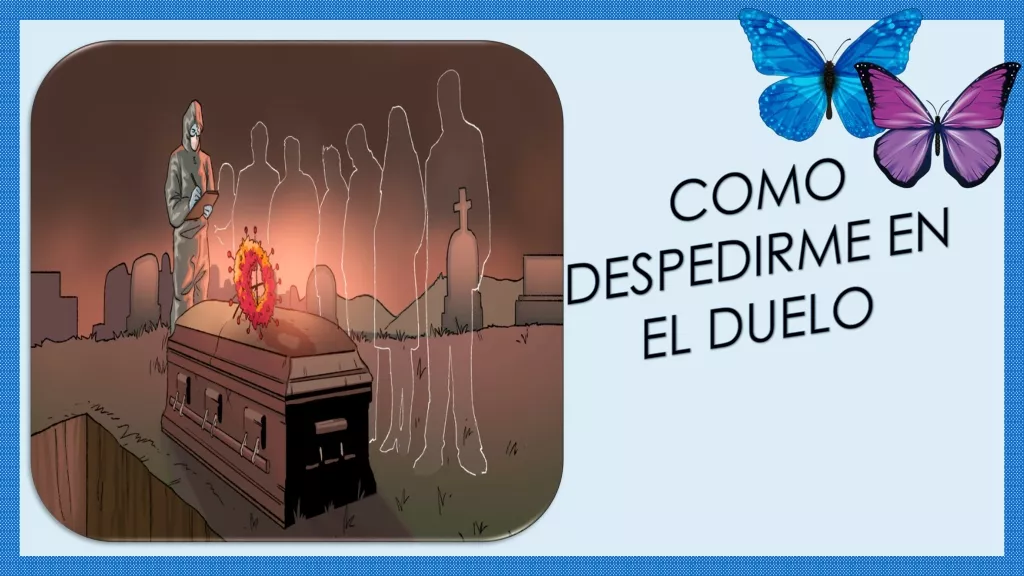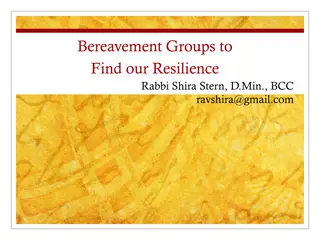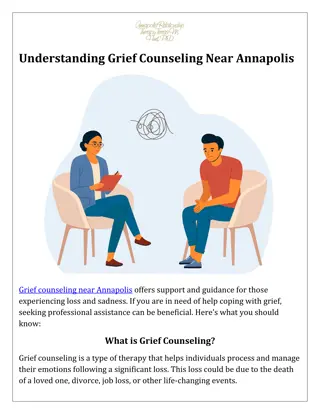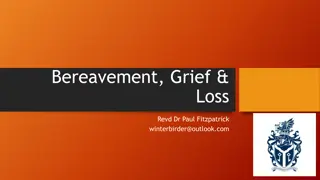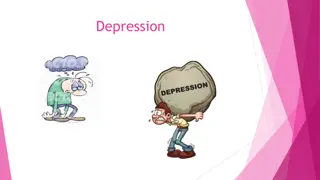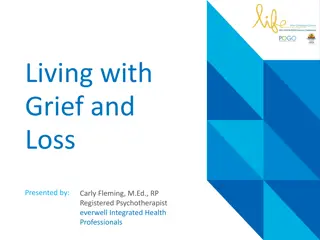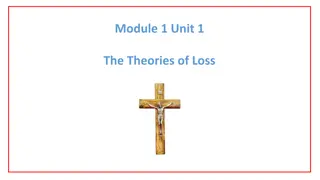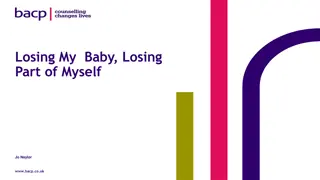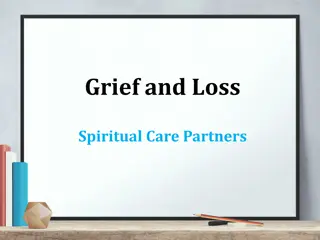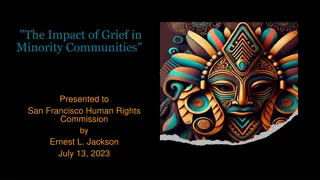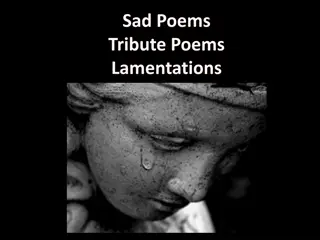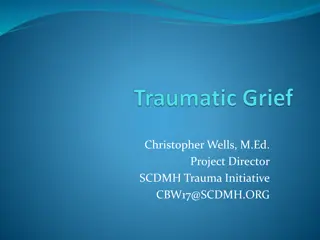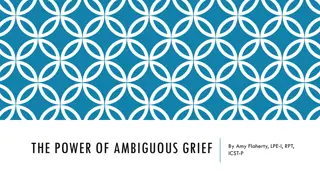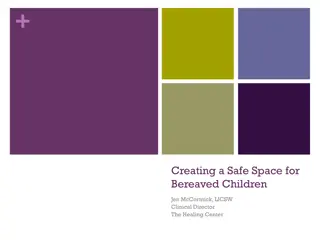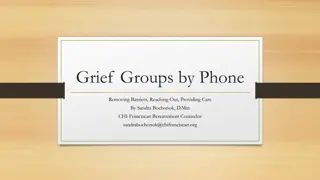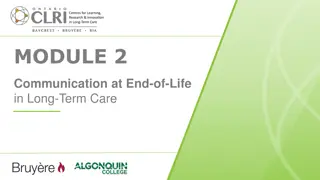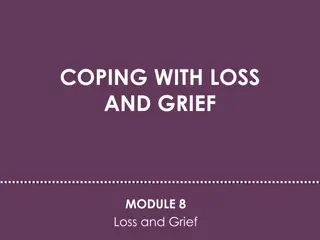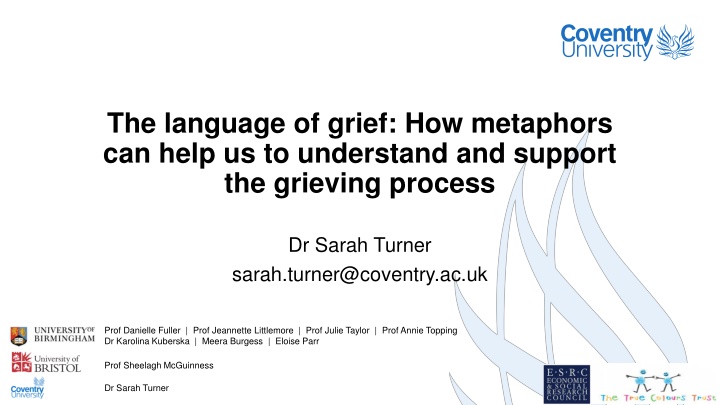
Understanding Grief Through Metaphors
Exploring the use of metaphors to navigate and support the complex emotions associated with grief, particularly in the context of child loss. Researchers delve into the power of language, highlighting how metaphors can offer unique insights into the grieving process and aid in providing more effective support and care for bereaved individuals.
Download Presentation

Please find below an Image/Link to download the presentation.
The content on the website is provided AS IS for your information and personal use only. It may not be sold, licensed, or shared on other websites without obtaining consent from the author. If you encounter any issues during the download, it is possible that the publisher has removed the file from their server.
You are allowed to download the files provided on this website for personal or commercial use, subject to the condition that they are used lawfully. All files are the property of their respective owners.
The content on the website is provided AS IS for your information and personal use only. It may not be sold, licensed, or shared on other websites without obtaining consent from the author.
E N D
Presentation Transcript
The language of grief: How metaphors can help us to understand and support the grieving process Dr Sarah Turner sarah.turner@coventry.ac.uk Prof Danielle Fuller | Prof Jeannette Littlemore | Prof Julie Taylor | Prof Annie Topping Dr Karolina Kuberska | Meera Burgess | Eloise Parr Prof Sheelagh McGuinness Dr Sarah Turner
The projects Improving communication with parents or carers who have lost a child 2016-2018 2018-2022 Interviews with 35 families who had experienced miscarriage, termination, and stillbirth, focusing on their experiences, decision- making and communication 21 interviews with parents, focusing on their experiences and communication with professionals Children aged between 17 days 28 years Using linguistic analysis to reach a deeper understanding of these experiences and to promote strategies for bereavement care that are grounded in this understanding.
The context The death of a child engenders a range of intense and complex emotions that may be difficult to articulate (Arnold & Gemma 2008) Particularly likely to engender complex, lasting grief responses due to e.g. trauma, societal taboo, or a lack of shared experience (see e.g. Littlemore & Turner, 2020; Neria & Litz, 2004) A supportive and understanding network is crucial to the grief process, as is support predicated on an understanding of the bereaved person s experiences (Riley et al. 2007) The complex emotions involved in grief, as well as the taboos around it, may make communication difficult (Arnold & Gemma 2008) This makes providing effective support a challenge How can we reach a better understanding of bereavement following pregnancy loss, baby loss or the death of a child? How can this support better care?
The power of language One of the doctors came along to tell us what was going on. And I can actually remember his words, exactly word for word all these years later... Years later, I can remember every word. I can even remember his tone of voice as he said it. Absolutely etched with acid into my brain
Etched with acid into my brain is a metaphor Any instance in which something is understood and described in terms of something else Normally, more abstract, less concrete, less tangible entities are described using more concrete, tangible ones (e.g. the more abstract having a strong, clear memory of an event is talked about using the action of etching something with acid, e.g. into metal ). We can think in metaphor, too and this can inform particular actions and behaviours. Metaphors can highlight some aspects of the experience, and downplay others. Metaphors can therefore give insights into how people are feeling about the concepts they are describing (e.g. Gibbs 2022) which can lead to better understanding and inform better care. Lakoff, G., & Johnson, M. (1980). Metaphors we live by. University of Chicago Press.
Metaphor is a very powerful instrument in the face of death. Experience that is mysterious, unfamiliar, frightening, lacking in stories, can be made sense of if parsed through the terms of something familiar, safe, known and validated. (Norwood, 2021, p. 120) Studying the metaphors used by the bereaved can help us to reach a deeper understanding of their experiences, and how these experiences might inform their evaluation of the care they receive.
Todays talk 1. What can metaphors tell us about how the death of a child is experienced? Altered relationship to time, space and the outside world; Continued parental identity and relationship with child 2. How can we use this understanding to shape bereavement care? It's the empathy. It's trying to get into our shoes to try and understand the situation, and then work around that.
Altered relationship to space, time and the outside world Many metaphors demonstrated a sense of disorientation, fragmentation and detachment following the loss. We felt like we were thrown from this one universe of wonderful normality... just forcibly thrown out into this awful universe of just misery and pointlessness The rest of the decision making, I don t know I was very zombified We just wanted to hide. Literally had this sense of I wanna get a cave, I don t wanna see the world, I don t wanna engage with anybody or anything It puts you out of sync with so like I was saying about my old playgroup friends they re all back to work, they re in a different time zone now. So yeah, like you re shifted aren t you? So you don t really fit where you started.
often conveying a lack of agency It put me in a very in a dark place for a quite a while I think the only thing that pulled me out of it was this kind of need to be pregnant again [Stillbirth is] like being thrown down a path that you didn t expect to go on. A bit like Sliding Doors? That suddenly something s happened, you re going that way, and you keep looking but eventually you can t see that path anymore... So you carry on your life, but you re in a new world. I compare it to, like, a parallel world. Like, I can see what our life would ve been, but this is where we are now I think the crux of it is that it will change everything about your life forever.
Implications for effective communication Clarity Time and pacing Explanation Timing seems to be really important, like giving you time and space And not hitting you with a whole load of stuff at once. And realising we might change our minds at times. We can t always be logical . Your mind is just messed up Give them plenty of time and don t be surprised if they re completely befuddled and they don t understand cos their brain isn t working properly. It s like you re full of cotton wool in your head and people do have to keep telling you things over and over and over again you ve got a woollen brain sitting in front of you
Lack of (effective) explanation can prejudice care A nurse put something in my mum s hands and it was inside a cardboard box and just said, Here s his memory box . So my mum was a bit like, Thanks . It was horrific for her there was no other explanation of it and we walked out and she just put it on the dining table when we got home. And like for days after everyone was like, What s in that box? , but no one dared open it because - my mum was saying, They said oh it s his memory box , I didn t want to open it in case it s his things in there .
Todays talk 1. What can metaphors tell us about how the death of a child is experienced? Altered relationship to time, space and the outside world; Continued parental identity and relationship with child 2. How can we use this understanding to shape bereavement care? It's the empathy. It's trying to get into our shoes to try and understand the situation, and then work around that.
Continued parental identity and relationship with the child Parents are often left feeling a strong and sustained bond with their deceased child (see Klass, Silverman, & Nickman, 1996; Klass & Steffen, 2018). The death of a child is seen as a threat to parental identity; participants expressed a strong desire to continue enacting their identities as parents after their child s death. I was distraught saying, My daughter s shut up and she s claustrophobic and they just didn t get they were just unsympathetic I felt. Even though you know by then it s just your child s body, you still don t want your child to be alone.
Hes mine you know, I wanna see him. So I rang back in the afternoon and the woman who answered the phone said, If you can get here now, you can have half an hour with him and she was like Get here now . So well we all just rushed in the car She said, You re allowed to see him, but you re not allowed to touch him . So I mean at that point I couldn t have cared less, I just wanted to see him because I was so sad he d been on his own.So we got there it was like a really horrible black comedy film. They didn t know we were coming Then when they were ready for us they put us in like this service lift down to the mortuary. Oh, it was just horrific. And the room is just really old-fashioned and it was cold, it was horrible. There was no child-friendly - there was like a token teddy bear on his bed and he had a duvet cover over him and then like this horrible crochet blanket that s obviously been there forever. At that point we got to take some of his teddies, so we obviously replaced the one that was there. And we had to be witnessed in there by the staff so that we didn t touch him and it was just the worst. Cos it s the instincts, like a parent s instinct to cuddle or even just to touch him, we weren t even allowed to touch his hair.
Then he said wouldnt recommend viewing, shes a mess and somebody came on his radio and he picked it up off his chest and went I can t talk now mate, I m delivering the dead message, ring me back, so I challenged him and I said the dead message?! That was my daughter a few hours ago and he didn t say anything, absolutely didn t say anything and there was just this silence [ ] it s the she s a mess that sticks with me and then because of that I think we didn t dare ask the undertaker if we could see NAME at all
Respecting the continuing identity of the child Demonstrating sensitivity to the enduring relationship between parent and child following a death. Respecting the child s identity and personhood; treating the body with care Providing parents with the option to interact with their child after death He rang and said, I m just letting you know, I ve popped him in the coffin and I ve tucked him up nicely.
Mitigating distress cause by procedural necessities They dropped off these cones, cos we had three funeral cars and the hearse [the funeral director] rang before and he said, I m gonna come and drop the cones off, now I m just telling you they re very grim cos they re black cones, with, like, a cross on them . I m sorry , he said, That s just what they are . That was really nice that we knew that. So my brother went out and bought these inflatable giraffes and he taped them to the top of the cone, so that was nice.
A word on the metaphors used withthe bereaved I have a real issue with the word 'loss', because it really bugs- it s a personal bugbear of mine. I used to get really annoyed when people used to say you know, sorry [for your loss] I didn tlosehim,hedied. Using words like 'letting go' or 'moving on', 'closure', 'grief resolution' - you know people are very resistant to that idea because it sounds like you re trying to introduce some sort of sense of, they vegottoputit down,andtheycan tandtheywon t. A lot of the Catholic priests that I did know at the hospital, they were saying things like, Well,it sGod s willandshe sinabetter place . And lots of people would say, Godmust veneeded anotherangel and I did say to myself once, The next person that says that is gonna be an angel themselves cos I was so fed up with it, sofed up with it.
Empathy and small acts of kindness Many of the parents we spoke to still remember small moments of empathy and kindness demonstrated by funeral professionals. Often these involved small recognitions of the child s enduring identity and personhood. These moments of recognition let parents know that they are cared for and supported and help to relieve feelings of isolation. I was in such a fragile hurt state, that any small act of kindness would have made a massive difference [The funeral director] was a parent of a 17 year old he said I went home and I cried and I held on to my daughter and I cried for you and for NAME and knowing that the funeral director absolutely was human and cried for us and for NAME, that was really comforting. We used to say to professionals, It s really worth your while you are doing good by shining a light in the dark for people
Wrapping up Effective communication demonstrates an awareness of, and sensitivity to, the experiences of the parents as conveyed through the metaphors they use Effective communication respects the child, and the relationship between the child and their parents/carers Metaphor analysis can help us to understand, identify and better respond to the needs of bereaved parents.
Acknowledgements Danny, and all the families who gave up their time to contribute to our research
References Arnold, J., & Gemma, P. B. (2008). The continuing process of parental grief. Death studies, 32(7), 658-673. Gibbs, R.W. (2022). What s figurative about figurative language? 6th International Conference on Figurative Thought & Language, Pozna , Poland, April 2022. Klass, D., & Steffen, E. M. (2017). Continuing bonds in bereavement. Taylor & Francis. Klass, D., Silverman, P. R., & Nickman, S. (2014). Continuing bonds: New understandings of grief. Taylor & Francis. Lakoff, G., & Johnson, M. (1980). Metaphors we live by. University of Chicago Press. Littlemore, J., & Turner, S. (2019). What Can Metaphor Tell Us About Experiences of Pregnancy Loss and How Are These Experiences Reflected in Midwife Practice? Frontiers in Communication, 4. Littlemore, J., & Turner, S. (2020). Metaphors in communication about pregnancy loss. Metaphor and the Social World, 10(1), 45-75. Neria, Y., & Litz, B. T. (2004). Bereavement by traumatic means: The complex synergy of trauma and grief. Journal of Loss and Trauma, 9(1), 73-87.
References Norwood, T. (2021). Metaphor and Neonatal Death: How Stories Can Help When a Baby Dies at Birth. Life Writing, 18(1), 113 124. Riley, L. P., LaMontagne, L. L., Hepworth, J. T., & Murphy, B. A. (2007). Parental grief responses and personal growth following the death of a child. Death Studies, 31(4), 277 299. Turner, S., Littlemore, J., Parr, E., Taylor, J., & Topping, A. (2022). Lights in the darkness , Part 2: Characterising effective communication with professional groups following the death of a child. Mortality, 28(4), 645-660. Turner, S., Littlemore, J., Parr, E., Taylor, J., & Topping, A. (2022). Lights in the darkness , Part 1: Characterising effective communication with professional groups following the death of a child. Mortality, 28(4), 627-644. Turner, S., Littlemore, J., Parr, E., Taylor, J., & Topping, A. (2022). Metaphors that shape parents perceptions of effective communication with healthcare practitioners following child death: a qualitative UK study . BMJ Open 12(1).

